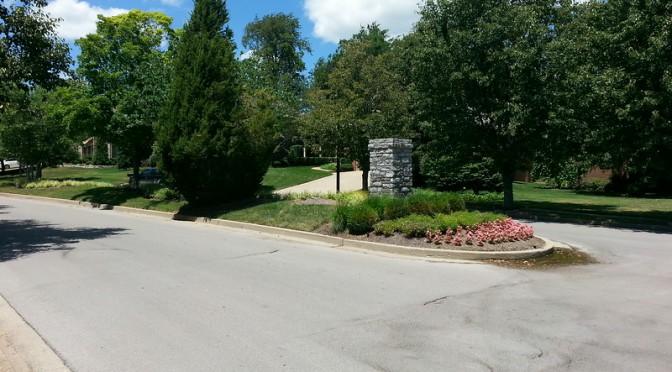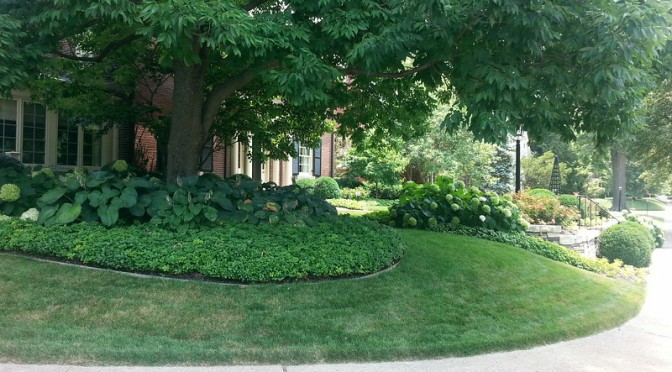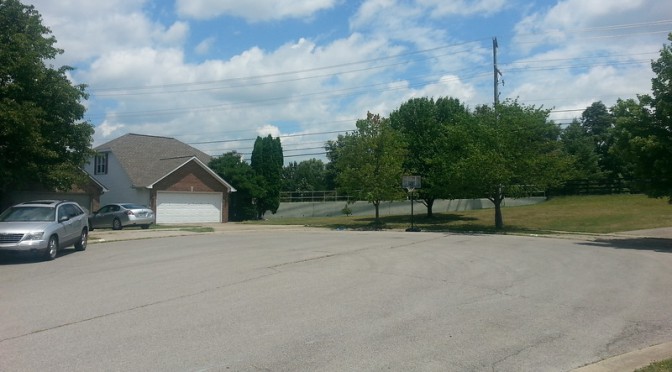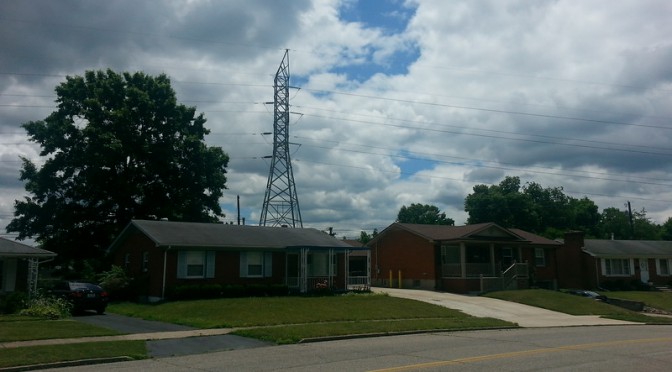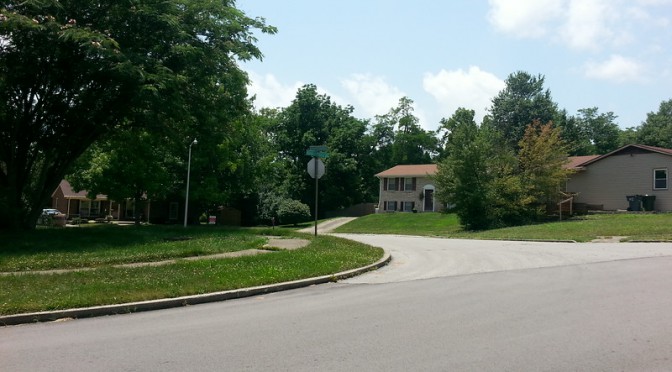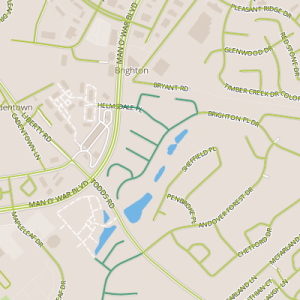 Today, I walked through the Andover Forest neighborhood, adjacent to Man O’ War at Todd’s road. Similar to Forest Hills walk on Day 8, these houses are probably from the same time and indeed, many of them have similar decorative keystones. The houses are larger here and perhaps unique from all the other neighborhoods I’ve visited thus far, nary a blade of grass was out of place. In fact, there was a variety of gardening techniques, though all seemed to leave at least some grassy areas intact. Another notable aspect of the lots here is that they are so large there are long moments where it can feel as if you’re in a particularly well-cared for park. One of the more interesting aspects of the sidewalk in this area is at the entrance to the neighborhood, which, instead of following the street, winds upward and through an archway, lending the path an air of mystery. This was the kind of thing I would really dig when I would casually explore on foot. This area has a series of ponds, so that most of the houses I passed on Brighton Place have large open space (if not the ponds themselves) visible behind them.
Today, I walked through the Andover Forest neighborhood, adjacent to Man O’ War at Todd’s road. Similar to Forest Hills walk on Day 8, these houses are probably from the same time and indeed, many of them have similar decorative keystones. The houses are larger here and perhaps unique from all the other neighborhoods I’ve visited thus far, nary a blade of grass was out of place. In fact, there was a variety of gardening techniques, though all seemed to leave at least some grassy areas intact. Another notable aspect of the lots here is that they are so large there are long moments where it can feel as if you’re in a particularly well-cared for park. One of the more interesting aspects of the sidewalk in this area is at the entrance to the neighborhood, which, instead of following the street, winds upward and through an archway, lending the path an air of mystery. This was the kind of thing I would really dig when I would casually explore on foot. This area has a series of ponds, so that most of the houses I passed on Brighton Place have large open space (if not the ponds themselves) visible behind them.
Monthly Archives: July 2014
Day 9
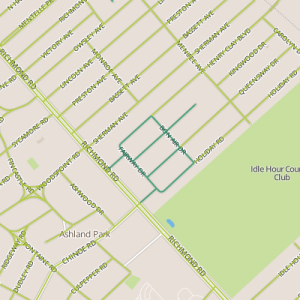 Today I strolled through the Fairway neighborhood, located next to Idle Hour Country Club and along Richmond. This is a neighborhood of homes built in the 1920’s and 30’s that tend to be on the larger side. I passed some modest homes (for example, on Henry Clay) but many of the homes in this area are grand, tall houses often with front doors located well above street level. This had some impact, as the scale felt different, more imposing than in newer middle-class neighborhoods. This neighborhood is laid out in a connected street grid, and the block length for the portion I walked is reasonable (around 750 feet; blocks to the northeast are longer), with the end result that the neighborhood felt comfortable and walkable despite the imposing homes. As you might expect in an old neighborhood, this area has some very tall trees; the wide tree lawns allow larger tree trunks than the 3 foot margins currently common.
Today I strolled through the Fairway neighborhood, located next to Idle Hour Country Club and along Richmond. This is a neighborhood of homes built in the 1920’s and 30’s that tend to be on the larger side. I passed some modest homes (for example, on Henry Clay) but many of the homes in this area are grand, tall houses often with front doors located well above street level. This had some impact, as the scale felt different, more imposing than in newer middle-class neighborhoods. This neighborhood is laid out in a connected street grid, and the block length for the portion I walked is reasonable (around 750 feet; blocks to the northeast are longer), with the end result that the neighborhood felt comfortable and walkable despite the imposing homes. As you might expect in an old neighborhood, this area has some very tall trees; the wide tree lawns allow larger tree trunks than the 3 foot margins currently common.
It was difficult not to walk in this neighborhood and not be conscious of the fact that these were homes to people who are doing well financially; perhaps not rich but certainly upper middle class. It comes out in the homes but also in the density of not just visual experience by auditory and olfactory experience. Variety not just in homes but in how yards are landscaped (thinking toward my question from my Day 8 walk, some yards have completely eliminated grass in favor of other ground cover that presumably doesn’t require nearly as much care). There were more smells, too, from a variety of plants to mundane home smells, and perhaps the canopy of trees kept smells in.
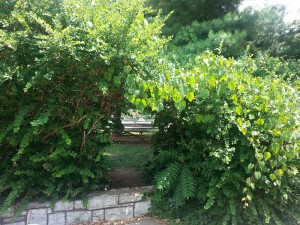
As it may have with sounds as well, since, the outdoors provided more variety of sounds, from a backyard fountain to the sounds of birds and kids playing that were clearer here than in past neighborhoods.
I think my dissatisfaction with planning largely arose from the fact that I felt it failed some of its social justice aims by making nice neighborhoods safe for gentrification while ignoring neighborhoods with significant design failures. Simple economics drives less wealthy families out of good (in the planning sense) neighborhoods into neighborhoods that provide less interest, fewer opportunities for serendipitous discovery. So what it is, exactly, about these nice, wealthy neighborhoods that make them so nice and to what extent could these things be copied, affordably (and ideally by residents ourselves) into the neighborhoods we can afford?
Day 8
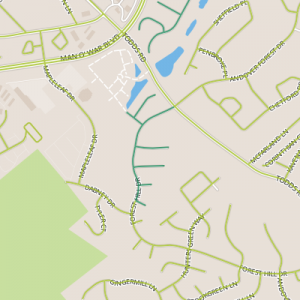 Today’s walk was through a mostly 1990’s vintage subdivision outside of Man O’War at Todd’s Road. The area is anchored by a large property at the corner of Todds and Forest Hill Drive. I really enjoy these older properties in neighborhoods which are often surprisingly modern. Unfortunately, this one is well hidden! But the property looks neat. Something else that occurred to me was that the infrastructure issues seen on day 7 have largely been ironed out (it seems) by the time this area was built out. No cul-de-sacs over culverts here; the cul-de-sacs all end at a similar greenspace though. Prior to walking, I suspected the forested area on the perimeter was stormwater-related. But this possibility seems unlikely after viewing at eye level as the roads seem to drain away from it; the infrastructure hidden here is something different! Speaking of drainage, I noticed a number of driveways that drain toward their respective houses. This seems almost intuitively to be a bad idea but it seems common here with the slab-on-grade construction.
Today’s walk was through a mostly 1990’s vintage subdivision outside of Man O’War at Todd’s Road. The area is anchored by a large property at the corner of Todds and Forest Hill Drive. I really enjoy these older properties in neighborhoods which are often surprisingly modern. Unfortunately, this one is well hidden! But the property looks neat. Something else that occurred to me was that the infrastructure issues seen on day 7 have largely been ironed out (it seems) by the time this area was built out. No cul-de-sacs over culverts here; the cul-de-sacs all end at a similar greenspace though. Prior to walking, I suspected the forested area on the perimeter was stormwater-related. But this possibility seems unlikely after viewing at eye level as the roads seem to drain away from it; the infrastructure hidden here is something different! Speaking of drainage, I noticed a number of driveways that drain toward their respective houses. This seems almost intuitively to be a bad idea but it seems common here with the slab-on-grade construction.
I was most focused today on front yards today, hoping to see neat yard solutions. Front yards seem universally kind of…neglected. They are mowed (or not) but largely they seem to be a patch of grass with no real reason for being. Of course, homeowners associations will limit the breadth of things that can be done. But I do expect to see some interesting things, especially in “covenant controlled” neighborhoods like my own. I think we can do better.
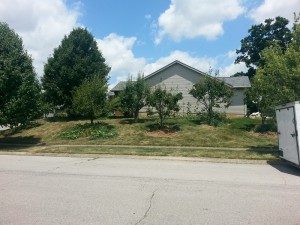
And I do see, in maybe one or two houses per mile or two I walk each day, really well-landscaped yards that I suspect take quite a bit of work and or artistry. These yards are nice, of course, but I’d really like to see the aesthetically not-bland yard for the rest of us.
Today’s walk did reveal a pretty earnest front yard garden with tomatoes, melons and some other vines that were generally kept inside the mulch ring around their trees (as much as you can restrict a zucchini plant, anyway).
Day 7
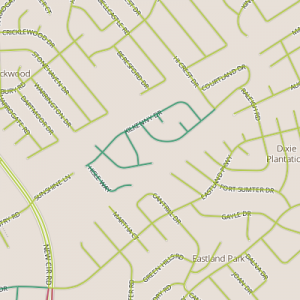 Today’s walk was through an earlier post-war neighborhood. This is tract housing to be sure, but there seems to be some character, perhaps some different housing styles, or just character from its age. It was possible to imagine this kind of neighborhood in the 50’s and 60’s, with tanned crew-cut boys playing in the yards, and it probably really doesn’t look too much different today. The Rookwood neighborhood seems to be the southern part of this area, dominated by duplexes and somewhat newer (and introduced by a pair of pillars at its entrance.) So Kenawood presumably makes up the rest of it, which (in these blocks at least) consists of construction from the mid-1960’s. There were some notable aspects. First, the lack of street trees is amazing, and makes a big difference in the feel of the neighborhood. Second, it feels somewhat as if infrastructure presented some unusual difficulties. Powerlines run through the middle of the neighborhood creating a gap-tooth appearance along some streets.
Today’s walk was through an earlier post-war neighborhood. This is tract housing to be sure, but there seems to be some character, perhaps some different housing styles, or just character from its age. It was possible to imagine this kind of neighborhood in the 50’s and 60’s, with tanned crew-cut boys playing in the yards, and it probably really doesn’t look too much different today. The Rookwood neighborhood seems to be the southern part of this area, dominated by duplexes and somewhat newer (and introduced by a pair of pillars at its entrance.) So Kenawood presumably makes up the rest of it, which (in these blocks at least) consists of construction from the mid-1960’s. There were some notable aspects. First, the lack of street trees is amazing, and makes a big difference in the feel of the neighborhood. Second, it feels somewhat as if infrastructure presented some unusual difficulties. Powerlines run through the middle of the neighborhood creating a gap-tooth appearance along some streets.
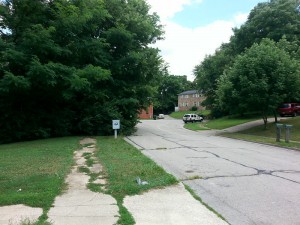
Meanwhile, a storm water ditch runs above ground in places, then runs under streets, including one cul-de-sac. Another oddity; the end of Hisle is a very long way from the nearest arterial (a full 1.8 miles from Eastland and New Circle Road), yet is virtually next to property along New Circle Road.
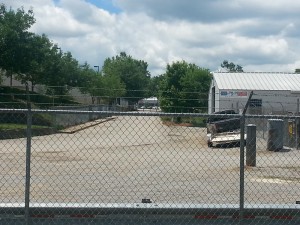
It doesn’t seem out of the question that roads could eventually connect and shorten that distance considerably; from Hisle and Kilkenny, one can look right down industrial Sunshine Lane and into the Green’s Toyota property. Currently, the way is blocked with barbed wire; the short walk presumably requires trespassing.
Day 6
 This walk was through a fairly typical suburban typology with the standard tree lawn and modest yard that I’m most familiar with. This neighborhood is south of Man O’ War, but the houses appear to be typically late 1970’s or 1980’s vintage (which seems to be backed up by parcel information). This also appears to be a Ball Home neighborhood. I’m certainly familiar with recent Ball Homes and neighborhoods, which seem to have certain common attributes. I was definitely surprised by the age, and somewhat surprised by the builder. Surely the age of the neighborhood makes it one of the older neighborhoods south of Man O’ War, though of course, I say this with only a limited sample set! No other surprises. There was quite a bit of lawn-mowing in progress. Also notable were the two yards decorated with pinwheels, which seems unique to me (though perhaps these are decorations in advance of July 4th!)
This walk was through a fairly typical suburban typology with the standard tree lawn and modest yard that I’m most familiar with. This neighborhood is south of Man O’ War, but the houses appear to be typically late 1970’s or 1980’s vintage (which seems to be backed up by parcel information). This also appears to be a Ball Home neighborhood. I’m certainly familiar with recent Ball Homes and neighborhoods, which seem to have certain common attributes. I was definitely surprised by the age, and somewhat surprised by the builder. Surely the age of the neighborhood makes it one of the older neighborhoods south of Man O’ War, though of course, I say this with only a limited sample set! No other surprises. There was quite a bit of lawn-mowing in progress. Also notable were the two yards decorated with pinwheels, which seems unique to me (though perhaps these are decorations in advance of July 4th!)
